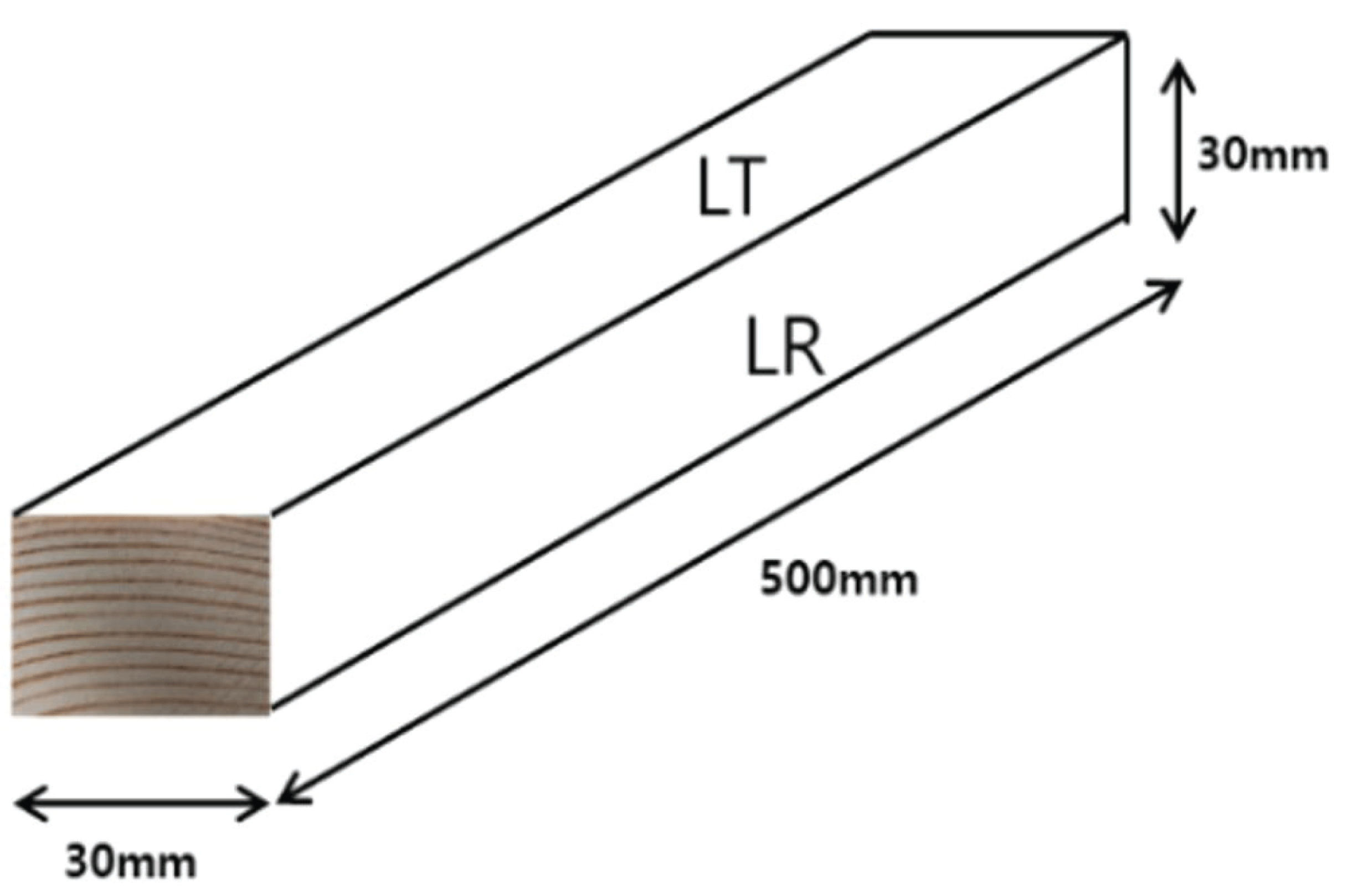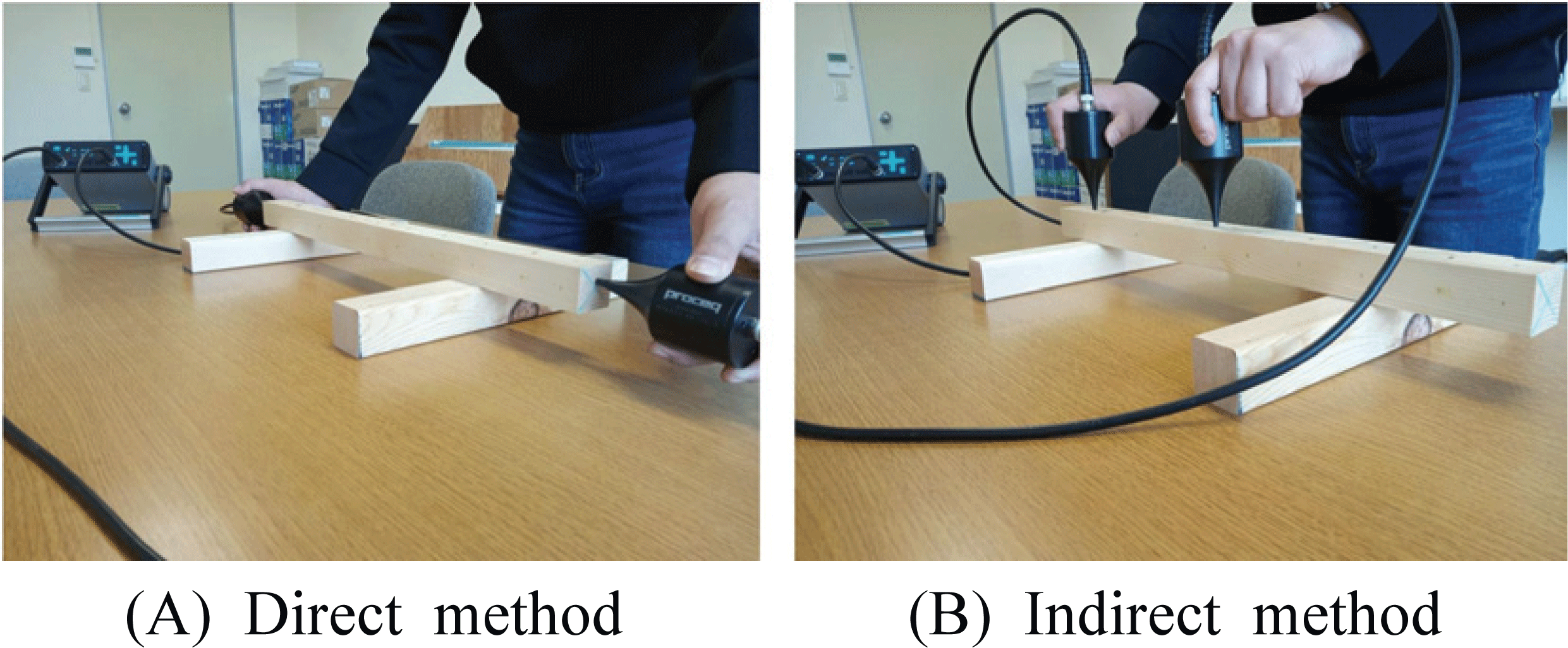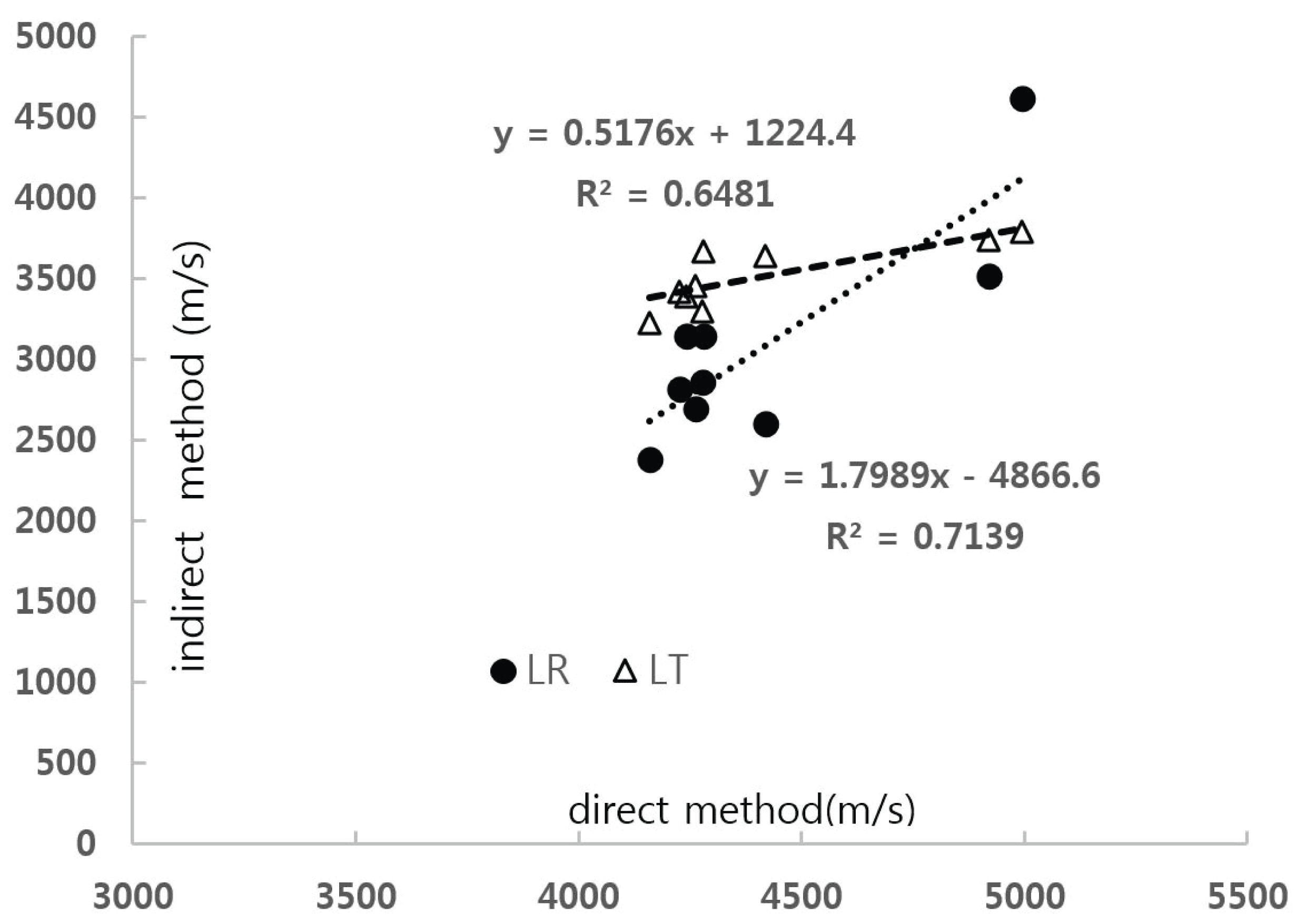1. INTRODUCTION
Ultrasonic method is a nondestructive technique measuring the speed of sound through materials in order to calculate elastic modulus and/or detect presence of internal flaws such as cracking, voids, decay and other damage (Sutan and Meganathan, 2003). This ultrasonic method is widely used to predict the mechanical properties of wood and detect wood defects. The mechanical properties of wood are affected by inherent characteristics like knots, slope of grain, reaction wood, anisotropy and physical properties like density, moisture content and service conditions. This ultrasonic test was used to determine the anisotropy of domestic lumber through measuring the ultrasonic velocity (Oh, 2017) and compare with destructive testing for bamboo oriented strand board (Sena Maulana et al., 2019).
The structural performance of timber construction is affected by materials strength and the safety of the timber structure is mainly based on the timber strength in service. The strength of timber in service is not possible to measure directly using destructive methods, so non-destructive method is needed for the inspection of the timber strength. The domestic timber construction market is growing since 1980s, and around 15,000 houses built per year. From now on, it seems that the proper inspection of timber construction is needed for the structural safety. The inspection of timber construction in service should be started to measure the strength of timber and this information will be useful to confirm the safety of construction. The ultrasonic test is frequently used to evaluate the timber strength nondestructively. It is possible to make measurement of pulse velocity by placing on opposite face (direct method), on adjacent face (semi direct method), on the same face (indirect method) in ultrasonic testing (Nobile and Nobile, 2015). Under service condition, only one face of timber is exposed, therefore standard direct method (longitudinal wave propagation between ends of elements) is not applicable (Machado et al., 2009). Because of this condition, indirect method is introduced in concrete (Savaliya et al., 2014) and wood. They compared ultrasonic velocities of simple cement concrete along direct, semi-direct and indirect method and pointed out that ultrasonic velocities affected by path length and small path length cause wrong results. Indirect method was applied to domestic lumber (Park and Hong, 2008) and wooden deck materials in service (Oh, 2015). The effect of density was studied with on nondestructive moisture meters and showed the density affected moisture content (Pang and Jeong, 2019). In spite of several research on measuring method, there is a lot of controversy on the effect of density, path length and plane of wood on the ultrasonic velocity.
The purpose of this study is to verify the effect of density on the ultrasonic velocities of wood, and distance between transducers and plane of wood through comparison between direct and indirect method.
2. MATERIALS and METHODS
30 pieces of spruce lumber with 35 × 35 × 3600 mm were purchased from local lumber supply company. Each sample used in this study was prepared as dried condition and processed with 30 × 30 × 500 mm. Total defect free 10 samples with flat sawn grain were prepared and classified two categories as tangential (LT) and radial section (LR) as shown Fig. 1. The test samples were conditioned in humidity chamber at 20°C ± 2°C temperature and 65% ± 5 % relative humidity before testing. Prior to testing, the test samples were weighed and their dimensions were measured to get the density according to KS F 2198. After testing, moisture contents were measured using electric resistance type moisture meter. The average density of samples was 445 ± 41.8 kg/m3 and moisture content was 9.0 ± 0.2%.
Ultrasonic test was carried out with two methods as direct and indirect method using Pundit Lab Plus test equipment. The pair of corn type (exponential) transducers with 54 kHz were used as transmitter and receiver. The direct method was conducted as shown in Fig. 2(A). At first ultrasonic coupling agent gel (pundit lab plus) was used and sample positioned LT plane as top and test was conducted. After that, the sample was rotated 90 degree and positioned LR plane as top and test was conducted, respectively, as shown Fig. 2(A). Measurement were repeated twice at each point and average was calculated. Second, indirect method was applied to the surface, LT and LR plane of same test samples as shown in Fig. 2(B), respectively. Transducers were kept on the same plane and measurement were also repeated twice at each point for calculating the average. The measurement process and order of measurement in indirect method was presented in Fig. 3(A) and (B). The distances between transducers (b) in indirect method were 50, 100, 150, 200 mm, respectively as shown in Fig. 3(A) and time t1 measured in first position of transducers. After this, time t2 was measured in second position 2b and surface velocity was measured. The ultrasonic velocity was calculated automatically by inputting the distance between two transducers.
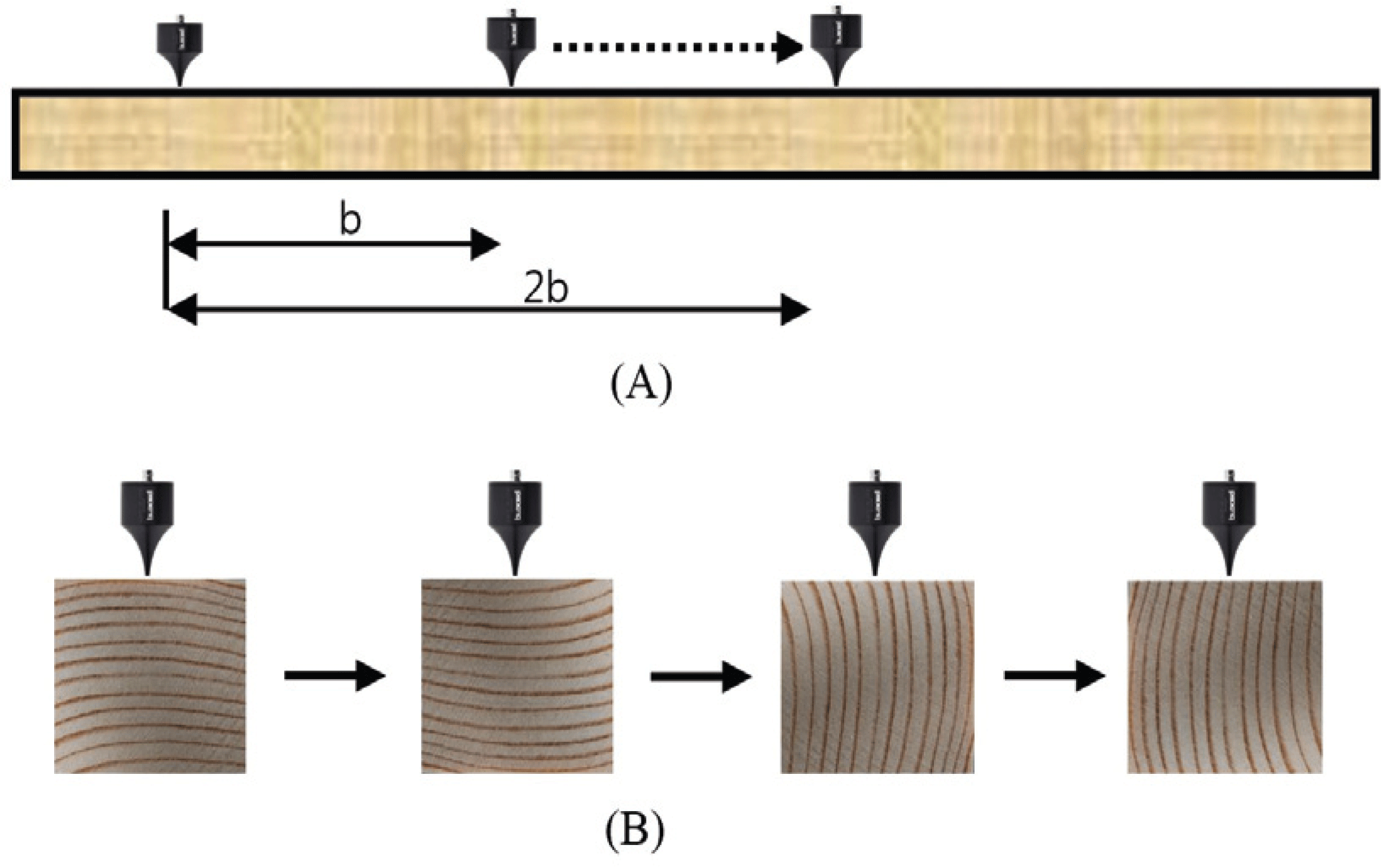
3. RESULTS and DISCUSSION
The average density of tested samples was 445 kg/m3 and ranged from 393 kg/m3 to 529 kg/m3. The measured ultrasonic velocity by direct method was ranged from 4160 m/s to 5081 m/s and average value was 4518 m/s in LT plane. The measured ultrasonic velocity in LR plane was ranged from 4028 m/s to 5123 m/s andaverage value was 4539 m/s. Linear regression models between wood densities and ultrasonic propagation velocities are shown Fig. 4. It was observed that good relationship between wood densities and ultrasonic propagation velocities and the coefficients of determination (R2) were found to be 0.75 in LT plane and 0.52 in LR plane. Bucur (1988) pointed out that the variations in density have a corresponding variation in ultrasonic velocity associated with it. Oliveira and Sales (2008) reported that the relationship between density and ultrasonic velocity was significant and the coefficients of determination (R2) were 0.80 - 0.88 for Brazilian tropical woods including one softwood and four hardwood species. In contrast to this paper, Barr et al. (2012) pointed out that ultrasound velocity variation due to change in density was not confirmed for any species. Other research confirms that the strong relationship was found between wood density and ultrasonic velocity, and the coefficients of determination (R2) were 0.78 - 0.94 for three softwood and one hardwood (Aydin and Aydin, 2018). From the test results, it was possibly concluded that the ultrasonic velocity tended to increase as the density of the wood increased and their relationship was positively correlated. The effect of wood plane on the ultrasonic velocity was analyzed statistically in LR and LT plane of wood. Analysis showed that the ultrasonic velocities in two planes were quite similar and statistically insignificant. This tendency was also found in another research paper (Ringger et al., 2003).
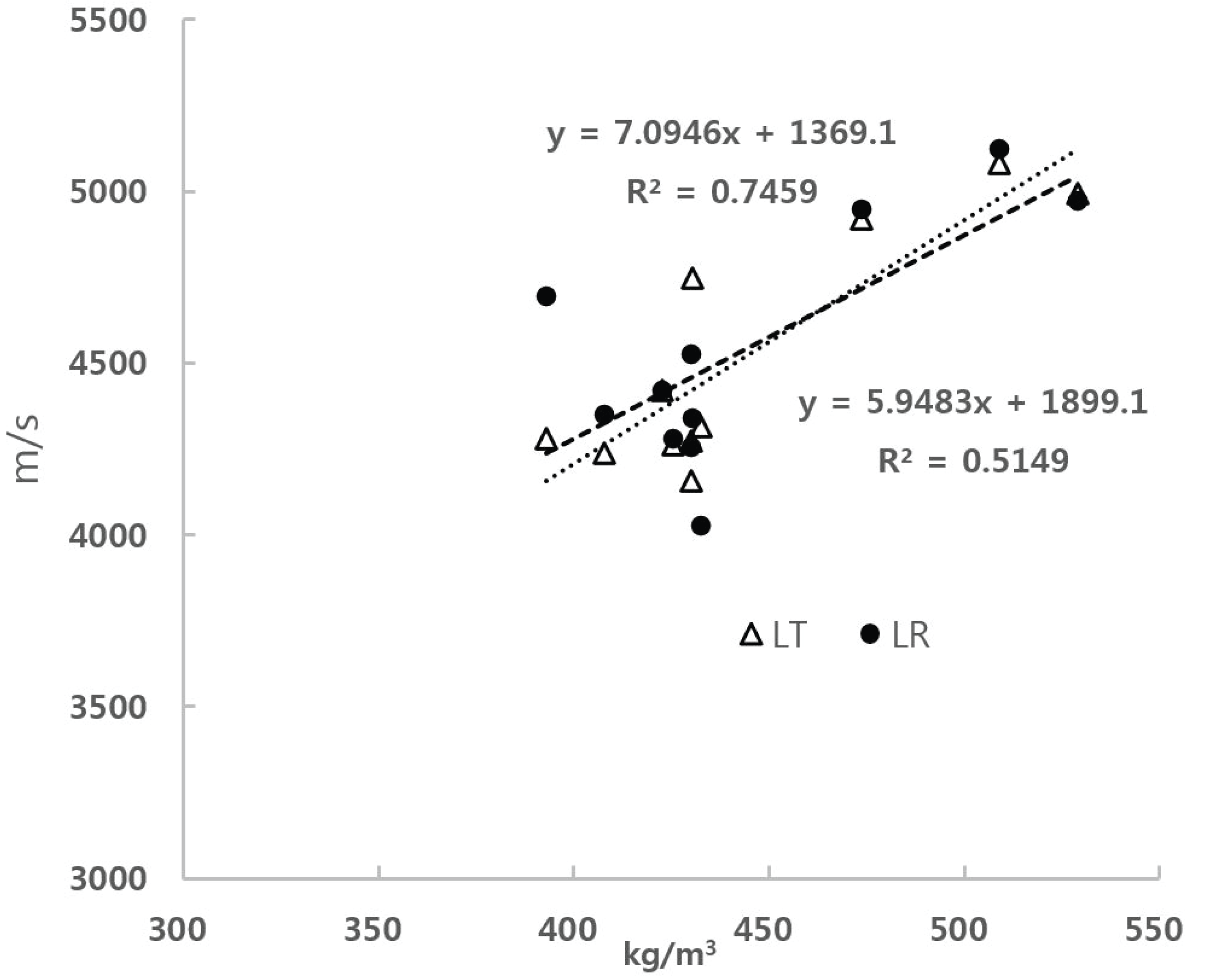
If the direct method which accesses to two surfaces is not legible, indirect method test is applied to surface transmission. The indirect method is least satisfactory upon sensitivity and defined path length, but it is more commonly used since direct method is not possible to use at most of time (Sutan and Meganathan, 2003). Surface transmission length (distance between transducers), mean, coefficient of variation and ratios to test methods of ultrasonic velocity were presented in Table 1. As shown in the Table 1, the ultrasonic velocity was increased with increasing the distance between transducers. Also, the coefficients of variation were 4.46, 2.22, 2.58, 2.70 % according to the distance, respectively. The ratios between direct and indirect method to ultrasonic velocity were also increased with increasing the distance between transducers and the highest value was 0.87 in 200mm length. Machado et al. (2009) compared the ultrasonic velocity between direct and indirect method and presented that the relative difference became lower as the distance between transducers was increased. This tendency was also found in this study. Senalik et al. (2014) pointed out that the specimen is thin, the traveling wave can reflect from the far side of the specimen and return to the sensor before the mechanical element in the sensor has come to rest. In this case, the reflected signal will be contaminated by element motion still present from the initial pulse. This means that the transducer distance in indirect method can affect the ultrasound velocity, and it is difficult to get the meaningful data in case of short distance between two transducers. Also, Savalita et al. (2014) insisted that small path wavelength in indirect method can’t go through depth so results may be faulty in concrete. From the test results and related studies, it is considered that the short distance between transducers is difficult to get the reliable data.
| Surface transmission length (mm) | Velocity (m/s) | |||
|---|---|---|---|---|
| Mean | COV (%)1) | Ratio2) | ||
| Indirect method | 50 | 1150.1 | 4.46 | 0.26 |
| 100 | 3486.6 | 2.22 | 0.79 | |
| 150 | 3777.0 | 2.58 | 0.85 | |
| 200 | 3869.7 | 2.70 | 0.87 | |
| Direct method | 4430.7 | 15.30 | 1 | |
To compare the ultrasonic velocity between LT and LR plane, the distance between transducers was 200 mm was considered reasonable and applied to analysis. The difference of ultrasonic velocity between direct and indirect method with 200 mm transducer distance was examined in two planes and their comparisons are presented in Fig. 5. The good correlation was observed in LR plane (coefficients of determination = 0.65) and LT plane (coefficients of determination = 0.72). Also, difference of ultrasound velocity between LT and LR plane was presented in Fig. 6. As a rule, the ultrasonic velocity of LT plane was slightly higher than that of LR planes except one case, but the difference was not found statistically significant (P(T<=t) = 0.099). Machado et al. (2009) compared the ultrasonic velocity between direct and indirect method and presented good correlation (coefficients of determination = 0.90). They used the distance between transducers 400 mm and showed more variable and lower value less than 200 mm. It was considered that limited number of samples could lead to higher correlation. As the sample has juvenile wood in one side, the velocity difference rate between top and bottom side of LT plane was somewhat higher about 73%. Palma et al. (2018) stated that ultrasound velocity in the inner zone was lower in the region of juvenile wood about 60-70% to mature wood in tangential direction. As a result, it was considered that the specific structure led to some degree of difference in the ultrasonic velocity at two side in the same plane.
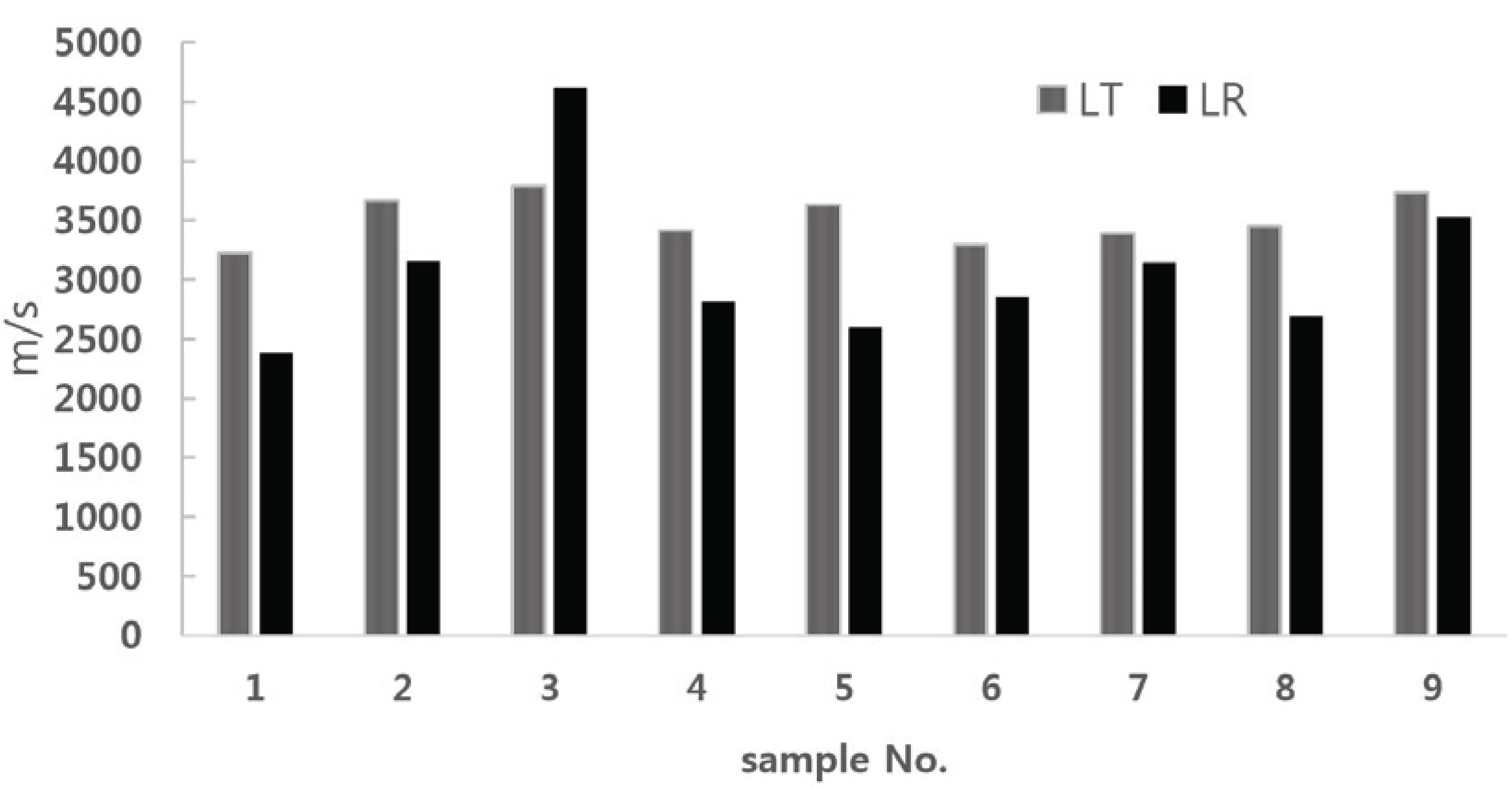
4. CONCLUSION
Results obtained by direct method shows that density had positive effect on ultrasonic velocity. In other words, increase in ultrasonic velocity observed as the density of sample was increased. Statistical analysis showed no effect of the influence between LR and LT plane.
The ultrasonic velocity was increased with increasing the distance between transducers and the coefficient of variation was 4.21% in the case of 200mm distance. The ratios between direct and indirect method were also increased with increasing the distance and the highest value was 0.87 in 200 mm distance. The distance between transducers in indirect method can affect the ultrasound velocity, and it is difficult to get the meaningful data in the case of short distance less than 100 mm. Overall, it was considered that the ultrasound velocity was affected by the transducer distance in indirect method.
The ultrasonic velocity of indirect method with 200 mm distance was examined in two planes and compared with direct method. The good correlation between direct and indirect method was observed in LT and LR plane. The velocity of LT plane was slightly higher than that of LR planes, but statistical analysis also showed no effect of the influence between two planes in indirect method the same as in direct method.

